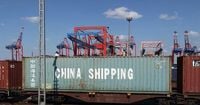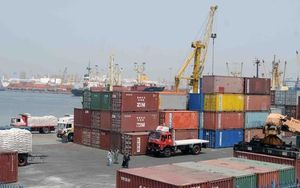The maritime transport industry is beginning to feel the repercussions of tariffs, with at least 80 ship voyages from China being canceled, according to a report published on April 17, 2025. This development is raising alarms among U.S. importers, who are being notified about the increasing number of canceled cargo ship voyages from China.
A total of 80 ship voyages have been canceled, as confirmed by the HLS Group. The ongoing U.S.-China trade war is causing a significant decline in demand, compelling transport companies to temporarily suspend or adjust their trans-Pacific services. The ONE ocean transport alliance, which is one of the largest in the industry, has announced that it has "temporarily suspended until further notice" a route they had planned to resume in May 2025. This route passes through key ports including Qingdao, Ningbo, Shanghai (China), Busan (South Korea), Vancouver (Canada), and Tacoma (USA).
As the number of container shipments to North America decreases, the impact on various links in the economy and supply chain is expected to be significant, affecting ports and logistics companies alike. If each ship now carries only between 8,000 and 10,000 TEU (Twenty-foot Equivalent Units), this translates to a reduction of approximately 640,000 to 800,000 containers. The decline in container traffic will lead to reduced crane operations at ports, decreased revenue from port fees, and diminished demand for truck and rail transport of containers to storage facilities.
On April 16, 2025, the World Trade Organization (WTO) warned that global trade prospects have "sharply declined" following the announcement of new tariff plans by President Trump. Alan Murphy, CEO of Sea-Intelligence, stated: "We have no way of knowing how significantly this drop in orders will affect shipping schedules... There are no models to predict this. What I can tell you is that the vast majority of containers on ships serving trade routes from Asia to the U.S. come from China. We won't reach a point where there are no containers, but we will see a reduction in container numbers and, as a result, a series of additional cancellations may be announced in the future."
Currently, China accounts for about 30% of the total container imports of the U.S., down from 37% in 2018. Moreover, it constitutes around 54% of total container imports from Asia, a decrease from 67% in the same year. This decline reflects the broader impact of tariffs on consumer goods, particularly in categories such as garments, toys, furniture, and sports equipment, all of which are subject to high tariffs in the U.S.
Bruce Chan, the global logistics director at Stifel, emphasized that the tariff policies have created substantial uncertainty regarding consumer demand. Retailers are becoming increasingly cautious about inventory levels, particularly in light of the overstock issues they faced during the post-COVID supply chain crisis of 2021-2022. Chan noted, "From our perspective, this uncertainty is beginning to manifest in canceled container voyages on major trans-Pacific routes, opening up the possibility of double-digit declines in container imports into the U.S. next month."
Recent booking data from the last week of March to the first week of April 2025 shows a sharp decline across global and U.S. trade routes, with certain categories, such as apparel and textiles, witnessing decreases of over 50%. The adjustments made by shipping companies are not limited to cancellations; they are also modifying or canceling entire shipping routes, commonly referred to as "ship chains." For instance, the ONE service from China to Vancouver and Tacoma has been impacted, which could also affect U.S. exports to Asia, given the interdependence of shipping routes.
Shipping companies need to ensure their vessels are fully loaded to generate profits. To achieve this, they often resort to various strategies such as canceling voyages, deploying smaller vessels, or adjusting sailing speeds. Murphy pointed out that 99% of shipping services operate weekly, with a round trip taking about seven weeks. "During COVID, shipping companies docked vessels for maintenance... They can also cancel a voyage entirely, abandon a shipping chain, use smaller ships, or slow down vessels that need to be moved further," he added.
These measures will reduce the available shipping capacity for containers, allowing remaining vessels to be filled, but they will also have unpredictable effects on overall shipping rates. While a reduction in voyages could lead to lower freight rates, history shows that during the COVID period, canceled voyages were identified by shipping companies as a reason for soaring container rates, which peaked at $30,000.
As demand and prices in the global supply chain continue to fluctuate, the situation remains volatile due to tariff policies. As trade with China faces increasing pressure, key indicators of shipping prices reveal that Vietnam's trade has surged in early April 2025. According to Xeneta, a platform that tracks shipping costs, sea freight rates—a representative measure of the cost of transporting goods—have increased by 43% since March 30, 2025.
In April 2025, the price of shipping from Ho Chi Minh City to Los Angeles spiked by 24%. Data compiled by Xeneta indicates that the fare difference between Shanghai, China's largest container port, and Ho Chi Minh City, Vietnam's largest container port, has also narrowed for shipments to the ports of Los Angeles and Long Beach.
Even with rising costs for transport companies, analysts like Peter Sand predict that they will continue to import from countries outside of China due to the unpredictable nature of the current situation. Sand remarked, "There is every possibility that higher tariffs will take effect after another 90 days or even sooner." This ongoing uncertainty highlights the challenges facing the maritime transport industry as it navigates the complexities of international trade amidst shifting political landscapes and economic realities.





